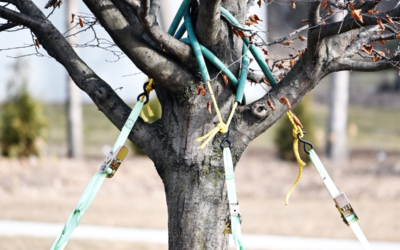Weathering the Storm: Protecting Your Trees from Nature’s Fury
Mother Nature can pack a punch, and when it comes to severe weather, our beloved trees can sometimes bear the brunt of her wrath. High winds, heavy snow, and even hail can leave a trail of broken branches and severe tree damage . But fear not, tree friends! By understanding the risks and taking some proactive steps, we can help our leafy companions weather the storm and emerge stronger on the other side.
Know Your Enemy:
First things first, it’s crucial to understand the types of severe weather that pose the most danger to your trees. Here are some common culprits:
- High winds: These ferocious gusts can snap weaker branches and even uproot entire trees, especially if the soil is saturated.
- Heavy snow: The weight of heavy snowfall can overload branches, causing them to bend and break. Wet snow is particularly dangerous.
- Hail: While hailstones may seem small, they can inflict significant damage, bruising leaves and breaking smaller branches.
Prevention is Key:
Just like preparing for any disaster, taking preventative measures can significantly reduce the risk of storm damage to your trees. Here are some valuable tips:
- Plant smart: Choose tree species known for their wind and snow resistance, and plant them in suitable locations away from power lines and structures.
- Regular trimming: A well-maintained tree with strong, healthy branches is more likely to withstand harsh weather. Pruning weak, dead, or overgrown branches regularly is essential.
- Strengthening techniques: In some cases, bracing or cabling may be necessary to provide additional support for vulnerable branches or trees.
When Disaster Strikes:
Despite our best efforts, sometimes severe weather takes its toll. If your trees suffer damage, follow these steps to stay safe and ensure proper recovery:
- Safety first: Never approach downed power lines or attempt to remove large branches or fallen trees yourself. Contact emergency services or a qualified arborist immediately.
- Assess the damage: Once it’s safe, take stock of the situation. Identify broken branches, fallen trees, and any potential hazards.
- Seek professional help: For extensive damage or if you’re unsure how to proceed, consult a certified arborist for expert advice and assistance. Contact us today! We offer free estimates!
Assessing the Damage:
After a storm, it’s crucial to take stock of the situation around your property. Look for:
- Downed trees or large branches: These pose an immediate safety hazard and should be reported to emergency services if they block roads or threaten structures.
- Cracked or broken branches: These can fall unexpectedly, so it’s best to remove them as soon as possible before a storm.
- Damaged leaves and twigs: While not as urgent, these can impact the tree’s health and aesthetics, so consider pruning them when safe to do so.
Safety First:
Remember, tree removal and trimming can be dangerous, especially after a storm. Here are some safety tips:
- Never attempt to remove large branches or fallen trees yourself. Always contact a qualified arborist for tree removal services.
- Stay away from downed power lines. Report them immediately to the utility company.
- Wear proper safety gear, including gloves, eye protection, and sturdy footwear, if you need to clear small debris.
Restoring Your Trees:
Once the immediate danger is addressed, you can start thinking about restoring your trees. Here are some steps to take:
- Prune away damaged branches. Make clean cuts at an angle just above a bud or branch collar.
- Assess the overall health of the tree. If the damage is extensive, consult with an arborist for professional advice.
- Water your trees deeply if weather allows. This will help them recover from the stress of the storm.
Preventing Future Damage:
Proactive measures can help mitigate storm damage to your trees:
- Regular tree trimming: This removes weak or dead branches that could break in high winds.
- Planting trees in suitable locations: Avoid planting trees too close to power lines or structures.
- Choosing sturdy tree species: Some trees are naturally more resistant to wind damage than others.
By following these tips, you can help your trees weather the storms and continue to thrive for years to come.
Remember: Trees are our leafy champions, offering shade, beauty, and vital habitat for wildlife. By understanding the risks of severe weather and taking proactive steps, we can prevent tree damage and help them stand tall and weather any storm. Let’s work together to keep our green giants reaching for the sky, come rain or shine!
Learn more about tree damage, limb removal, and cleanup after a storm from the Denver Office of the City Forester.
Contact us today at (303) 623-8733 (TREE) or send us a request for a Free Estimate. Take a look at our Tree Care services for more information. Our service areas include Centennial, Cherry Hills Village, Denver, Englewood, Golden, Greenwood Village, Highlands Ranch, Lakewood, Littleton, Lone Tree and Wheat Ridge. We look forward to hearing from you!
Stay safe, tree friends!




